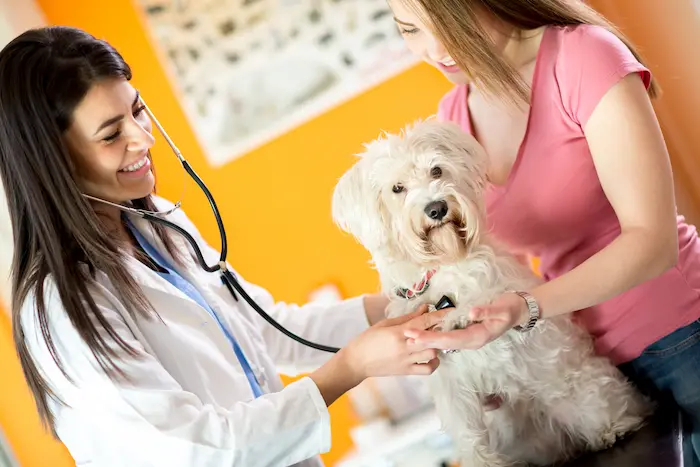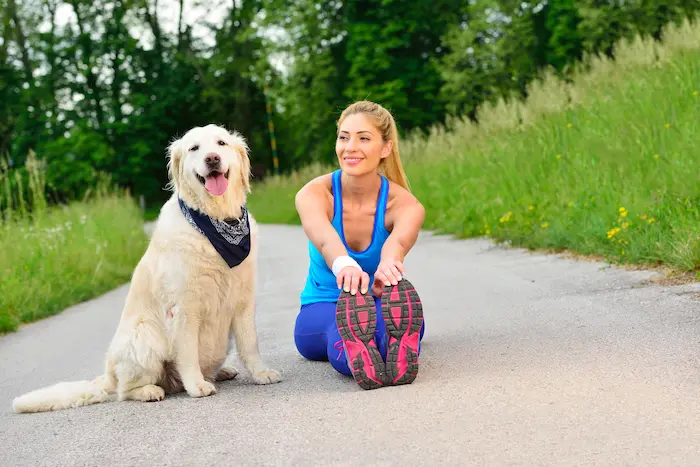
Springtime’s sunny days and higher temperatures mean more time for dogs to play and explore outside with their human pals. More time outdoors, however, can also mean increased safety risks. Dogs can find trouble in rough natural spaces, and hot weather can be a health hazard. And unfortunately, dogs and allergies go hand in hand in the springtime. Protect your dog when spring arrives with these safety tips to help you keep your dog safe this season.
Recognizing and Managing Dogs and Allergies
Seasonal allergies can affect dogs as much as humans. Allergens in the air — like pollen or dust mites — can leave your pet irritated and uncomfortable. Luckily, you can take steps to relieve allergies in dogs so your pup can get back to enjoying the warm spring days. Here’s how to manage pet allergies, starting with understanding what they are.
Common Dog Allergies in Spring
Get familiar with the source of seasonal allergies so you can identify them when they arise. In the spring, as plants bloom and blossom after a dormant winter, the wind carries their tiny seeds, which can affect canines and humans alike. Other environmental allergens can also trigger a reaction in your pup. Some of the most common allergens are:
- Tree pollens
- Pet dander
- Mold spores
- Weed pollens
- Mildew
- Dust mites
- Grass pollens
- Flea saliva
Symptoms to Watch For
Knowing the symptoms of seasonal allergies in dogs makes you more likely to recognize them when they arise. And if you can spot the signs, you can follow up with an allergy attack plan. Some of the most common pet allergy symptoms are:
- Chronic ear infections
- Excessive shedding
- Sneezing
- Difficulty breathing
- Watery eyes
- Abnormally dark or thick skin
- Inflamed, itchy or irritated skin
- Paw licking and butt scooting
- Skin biting and face rubbing
Reducing Allergen Exposure
Unlike food allergies, seasonal allergies work themselves into a dog’s skin, which is why biting and scratching are so common in allergy-affected dogs. So to relieve your dog’s allergy symptoms, the first step is to reduce exposure.
It’s likely not reasonable to keep your dog inside all spring, but you can reduce the number of allergens that infiltrate your home. Try using the following allergy-elimination strategies:
- Wipe off your dog’s body before it comes indoors
- Wash its bedding in hot water weekly.
- Vacuum carpets often.
- Have your dog groomed regularly.
- Opt for air-conditioning over open windows.
- Give your dog hard chew toys instead of soft ones, which can harbor allergens.
- Employ dehumidifiers to prevent mold in kitchens and bathrooms.
- Implement strict flea-control measures.
Consulting a Vet
If your dog’s allergies don’t improve, it’s best to consult a veterinarian. Without treatment, allergies can morph into serious conditions like bacterial infections and atopic dermatitis. Consult your vet as soon as possible to begin a treatment plan for your pup, which may include solutions like allergy shots or antihistamine medication.

Outdoor Safety Tips
While it’s tempting to let your dog roam free in the crisp green grass, safety should always come first. Pet owners should be aware of risks that can come with increased time spent outdoors: environmental dangers, pests and heatstroke.
Outdoor walks are part of a healthy canine lifestyle, and you and your pup will both enjoy being out in the warm springtime sun. But more frequent strolls require a higher level of mindfulness. This means staying watchful to ensure your pet doesn’t get too close to wildlife and recognizing toxic plants that may prompt an allergic reaction. Many pet owners find wireless GPS fences helpful for keeping a dog’s adventure limited to a safe space. The Halo Collar is a popular choice that doubles as an effective training tool.
Pests represent another safety risk that extends well beyond springtime. If left unchecked, they can leave your dog with allergy symptoms — or worse, secondary skin infections. Flea allergy dermatitis can result in itchy skin and hair loss. Investing in year-round flea and tick prevention can keep your dog protected, as can keeping your lawn trimmed and inspecting your dog for ticks after being outside.
After a long, cold winter, heatstroke is likely the last thing on your mind. But when the weather warms up, a too-hot day can catch you by surprise. As the temperatures increase, consider limiting your dog’s outdoor time during the hottest part of the afternoon. Instead, opt for morning or evening activities to ensure your pup still gets enough exercise.
Giving your dog a shady place to rest and unwind can make outside time possible even when it’s warm. A GPS fence, like the ones made by Halo Collar, can also be used to ensure your dog stays within cooler bounds. Provide your dog access to water at all times to minimize its risk of developing heatstroke.
Diet and Nutrition for Allergy Prevention
A healthy diet can be one of the best defenses against allergies in dogs. Certain foods, like spinach, kale, carrots and berries, can give dogs an immune system boost. This may lower the effects of environmental allergies to manageable levels. Foods rich in omega-3 fatty acids can nourish a pup’s skin and paws — useful when battling inflammation. Look for dog food with ingredients like whitefish, salmon and nut butter, and ask your vet for a list of specific foods to incorporate.
And while those puppy-dog eyes are nearly irresistible, avoid giving your dog table food. Dogs have different digestive systems than humans, and many of the foods we eat aren’t easily broken down inside canine stomachs. The result is often an avoidable case of vomiting, diarrhea or a more serious issue like pancreatitis. Some table foods are downright toxic to dogs and may produce an allergic reaction. As a general rule, it’s best to avoid sharing your meals with your pet altogether.
When making changes to your dog’s diet, it’s important to be conscious of food allergies. If you aren’t sure which foods to omit, consider discussing allergy testing with your vet to find out.

Dog Exercise and Mental Stimulation
Physical activity keeps dogs happy and healthy and offers a great way to spend quality time with your furry friend. But to reap the benefits of outdoor time, safety must be a top priority.
Get in the habit of assessing outside risks before you go out to play. On hot days, consider limiting outdoor time to cooler hours or sticking to shaded areas. And when airborne allergens are plentiful, take care to reduce your dog’s exposure.
If you’re stuck indoors for the day, you can still keep your pup engaged. This is a good time to break out the puzzle toys, practice scent training or play a game together. Plus, these activities double as excellent forms of mental stimulation.
Embrace Springtime Adventures With Your Pup!
Whether it’s food allergies, tree pollen or heatstroke that concerns you this spring, there’s a lot you can do to keep your dog safe. With a solid knowledge of allergy symptoms, outdoor safety strategies and a healthy diet, you and your pup can have a ball exploring the warmed-up world this season. And if you need some extra support, you can always turn to your veterinarian.
When it comes to spring safety, there’s no better tool than the Halo Collar. Find out more today, and set yourself up for a season of springtime fun.






